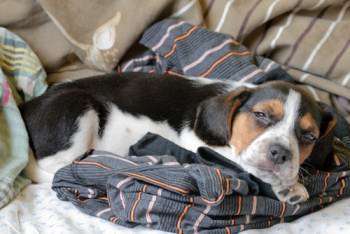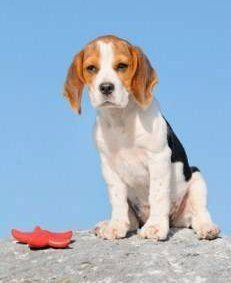Pocket Beagles
Miniature Beagles | Pocket Beagles
The Truth About Pocket Beagles
There is no such recognized breed as the Miniature Beagle, Pocket Beagle, or any other name that implies that there is a separate and distinct dog breed, smaller than the standard Beagle.
There is only one official Beagle dog breed.
Long ago in Medieval times, there was a small dog breed, referred to as a Pocket Beagle. Those dogs stood 8 to 9 inches. They were small enough to fit in a 'pocket' or saddlebag of hunters, thus giving them this name.
Queen Elizabeth I reportedly entertained guests at her royal table by letting her Pocket Beagles romp and bounce around the serving platters, as this could be done without ruining the dinner-table since they were so little and her guests were said to really enjoy the show.
This type of beagle is now extinct, it's genetic lines lost forever, its heritage left to the imagination.
In these modern times, the only official Beagle breed ranges from 20 lbs. ( 9.07 kg) to 25 lbs. (11.34 kg). Its height ranges from 13 inches (33 cm) to 16 inches (40.6 cm) depending on the official dog registration standards.
For example, the AKC recognizes 1 Beagle breed in 2 varieties: 13 inches in height (33 cm) & between 13 and 15 inches in height (33-38 cm). Other registries recognize 1 variety of the breed which is 13-16 inches in height ( 33-40.6 cm).


There's no reason to breed a Beagle down in size; he is at a healthy size when meeting the standard.
So, Why Do We Hear About Miniature Beagles?
The media and other sources convey that having a tiny dog is "special". This is seen often with other breeds beside the Beagle
such as the Pomeranian, Chihuahua and Yorkshire Terrier. Some breeders will advertise Pocket Beagles to meet the public's demand for a tiny dog.
In some cases, breeders are trying to mimic the dogs of earlier generations that were seen looking back at the origin of the Beagle... Those tiny 9 inch high hunting dogs which were popular during the end of the 1400's and the royal pets of the 1500's..
However, those small dogs were gradually bred to be stronger, with larger bone structure, bigger in both height and weight. It has been centuries since Pockets existed.
With so many generations of standard sized Beagles, it is not safe to purposely breed dogs that are so much smaller than the set standard. Yet some are trying to go back in time to bring about a dog that simply does not exist any longer.
Any Beagle that is substantially smaller than the AKC standard is not seen as its own breed, he is only seen as a dog that has a major fault: he is too small to fit the breed standard and this can bring about a variety of health issues.
Does this Mean There Are Tiny Beagles?
There
are Beagles that are much smaller than the breed standard and these dogs are bred unethically or are not purebred Beagles. Real Pocket Beagles are extinct, the bloodlines gone forever. Today's Beagles that are far under the breed standard weight will usually have many health issues.
They can have underdeveloped organs, diabetes, thyroid problems and more. And let's not forget that they are not a separate breed. They are a deviation from the standard and purposefully producing such dogs is not seen as following the "breeding for the betterment of the breed" motto that most ethical breeders follow.
How Do Beagles Get to Be So Little?
Beagles can be bred down to sizes much smaller than is safe, by the process of breeding together "runt" dogs. It is not uncommon for a litter to contain at least one dog that falls to the lower end of the standard, 20 lbs. (9.07 kg) fully grown.
Those hoping to produce a so-called Pocket Beagle will then pair such a small dog (referred to as the runt of the litter) to another runt of the litter. In some cases, since finding such small dogs is not an easy task, inbreeding is done.
The method of inbreeding is a controversial one, since this means that mother is paired with son, brother to sister and so on. The goal is to produce smaller than natural dogs and sadly, this means dogs that can suffer from a host of medical issues.
Since a "runt" dog can be susceptible to many health conditions, this takes those health issues and pushes them down the breeding line. This is unethical, to say the least.
In other cases, a Beagle is bred with another toy or small dog breed. In some cases, the puppy will resemble a Beagle, but will have the genes of a smaller dog breed; thus making the dog tiny. When this happen, sometimes, the dog will appear to be a Beagle while he is a young puppy, but as the dog matures, features of the other bred begin to emerge and it is only then that owners may suspect that this method was done.
When a Pocket Beagle is produced in this way, it could be that the ears do not drop correctly, a longer coat grows in, the muzzle appears narrow or other body structure elements that make it more and more obvious as the pup grows into an adult.


If You Have a 'Pocket Beagle'
If you were not aware of the major health issues that can occur and you do have a miniature Beagle dog, you must be aware of the very probable health issues.
The most common canine health problems to be aware of are:
- Hypoglycemia - a fast drop in blood sugar which can be fatal
- Organs that do not develop properly - This can cause everything from heart failure to liver problems
- Tooth disease
- Diabetes
- Increased risk of luxating patella and hip dysplasia
Your smaller than average dog should not be expected to be able to handle all of the activities of the standard Beagle.
You may need to go for shorter walks so to prevent too much strain on the dog's heart. Be aware of cold temperatures; as your pet may have trouble controlling body temperature. Your veterinarian should be regularly checking for heart, liver and kidney issues. Dental care
will be more important than ever.
As with any small dog, be careful where you step and take care in regard to sofas and beds. You may wish to obtain doggie steps so that he or she does not jump off of high objects, as this can cause injury.
How to groom a Beagle: From keeping the tightly packed coat super healthy & shiny... to making sure that ears are cleaned properly.
Beagle photo gallery: Beagles of all ages, send in by readers & Members of the site.
Good names for a Beagle: A great list of names, sent in by owners.
Popular Beagle hybrid dogs: Photos and details of Beagle designer dogs. Hybrid vigor explained.
Share Us
Share
Tweet
Share
Mail
All text and photographs protected by US and International copyright laws.
Copyright. BeaglePro.com
We are a participant in the Amazon Services LLC Associates Program, an affiliate advertising program designed to provide a means for us to earn fees by linking to Amazon.com and affiliated sites.

